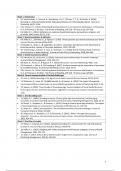1
,01. Swaminathan et al. (2020). Hyperconnected world
- Blurring & broadening
- Firm, consumer, society views
- Three boundaries of branding: information availability and speed of information
dissemination, networks of people and devices and the growth of platforms,
device-to-device connectivity
02a. Schultz, D.E. (2016). Rethinking Brand Development in an Interactive Marketplace.
- No Brand Preference
- Adapt through 6 areas: shift to behavioral data, longitudinal analysis, networked
systems, multidimensional models, financial focus and connection other
organisations in brand development
03. Keller, K. L. (2016). Reflections on customer-based brand equity.
- Brand positioning model, Brand resonance model, Brand value chain model
- Brand knowledge: brand awareness, brand image
- Functional vs. symbolic associations
04.Keller et al. (2002). Three questions.
- Have we established a frame of reference?
- Is the PoD compelling?
- Are we leveraging our PoP?
05. Maehle et al. (2011). Brand personality.
- Human-like characteristics associated with brand
- Sincerity, competence, excitement, sophistication and ruggedness
06. Vredenburg et al. (2020). Brand activism.
- 4 key characteristics of brand activism
- Brand activism: absence, silent, authentic, inauthentic
- Zone of outrage, delight and satisfaction
07. Fetscherin, M., & Heinrich, D. (2014). Consumer brand relationships.
- Brand connection matrix (functionally invested, fully invested, un-invested,
emotionally invested)
- Brand feeling matrix (satisfaction, love, avoidance, hate)
08. Batra, R., Ahuvia, A., & Bagozzi, R. P. (2012). Brand love.
- Long customer-brand relationships
- Strong and weak features
- 3 strategic implications (facilitate passion-driven behaviours, create positive
emotional connection, facilitiate self-brand intergration)
- Link 2 keller’s resonance
2
,02b. Schultz, D.E. (2016). Commodization.
- Brand Asset Valuater (strenght & stature)
- Strategic impact of brand strength (unrealized potential, commodity brand, cultural
icon)
- No brand preference → Commodization FMCG
9. Romaniuk, J., Sharp, B., & Ehrenberg, A. (2007). Evidence concerning the importance of
perceived brand differentiation.
- Sharp’s rule: mental availability (salience) and pysicsl availability (distribution)
- Brands are differentiated at category-level not at brand level
- Awareness/salience; differentiation not important
- Focus on distinctiveness; stand out (primary brand elements, consistent marketing
communication)
10. Holt, D. (2016). Branding in the age of social media.
- Crowdculture (real cultural innovators, specialized entertainment content, competing
with brand content)
- 5 steps cultural branding (map the cultural orthodoxy, locate the cultural opportunity,
target the crowd culture, diffuse the ideology, innovate continuously with cultural
flashpoints)
11. Nickerson et al. (2022). Corporate social responsbility.
- Corrective, compensating, cultivating CSR
- CSR type, CSR focus, CSR, reputation, Perceived brand sincerity and brand
purchase.
12. Supran, G. (2022). Greenwashing.
- Climate silence, greenwashing, misdirection, nature-rising, geographic greening
13. Keller, K. L. (2005). Branding shortcuts/elements
- Shortcuts; immediate recognition; free advertisement
- Crieteria for evaluating primary brand elements: offensive and defensive
- Offensive (memorability, meaninfulness, likeability)
- Defensive (trasferability, adaptability, protectability)
14. Bossel, V., Geyskens, K., & Goukens, C. (2019). Brand logo.
- Simplicity, processing fluency, non-prestegious products
15. Keller, K. L. (2003). Brand synthesis
- Brand leveraging process: linking to external entity and transferring positive
associations; two-way interaction; commonality strategy
- Sources of secondary knowledge (customer knowledge of entity, meaninfullness and
transferability)
3
, 16. Magnusson et al. (2002) Country of origin
- Perceived Coo affects product evaluation and behavior even if the perception is
wrong
17. Moon & Sprott (2016). Ingredient brand
- Brand image fit and product category fit; positively influences consumer purchase
intentions.
- Perceived luxury is a central driver of consumer preference, purchase intentions and
usage of luxury products
- Brand image fit is more important for high luxury
- Product category fit is more important for low luxury brands
18. Keller, K. L. (2014). Brand architecture
- 3 steps
- (1) Defining potential and boundaries of brands: brand vision, boundaries and
positioning
- (2) Identifying product or survise extensions: brand equity, perceived fit
- (3) Specifying the brand elements and positioning: hierarchy, portfolio
- Upwards BH → HoB = coverage segments = new brands
- Downwards Hob → BH = leverage brand equite = new extensions
19. Shah, P. (2017). Delete firms
- Financial underperformance, failure to meet consumer needs and preferences,
portfolio inefficiencies, strategic misalingment
20. Brand extensions (Dwivedi, Aaker & Keller, Park, Milberg & Lawson)
- 2 processes: extension evalution & feedback effects
- Aaker & Keller 3 criteria for fit (subsitutability, consistency, trasnfer)
- Park, Milberg & Lawson extra criteria: Brand Consisentcy Concept (BCC)
21. Brand architecture (Keller; Aaker & Joachimsthaler)
- Keller Brand-Product mix: depth, breadth; overview of brands activities
- Keller Brand Hierarchy: organises into 5 levels
- Aaker & Joachimsthaler Brand Relationship Spectrum: driver role (low vs. high);
4




